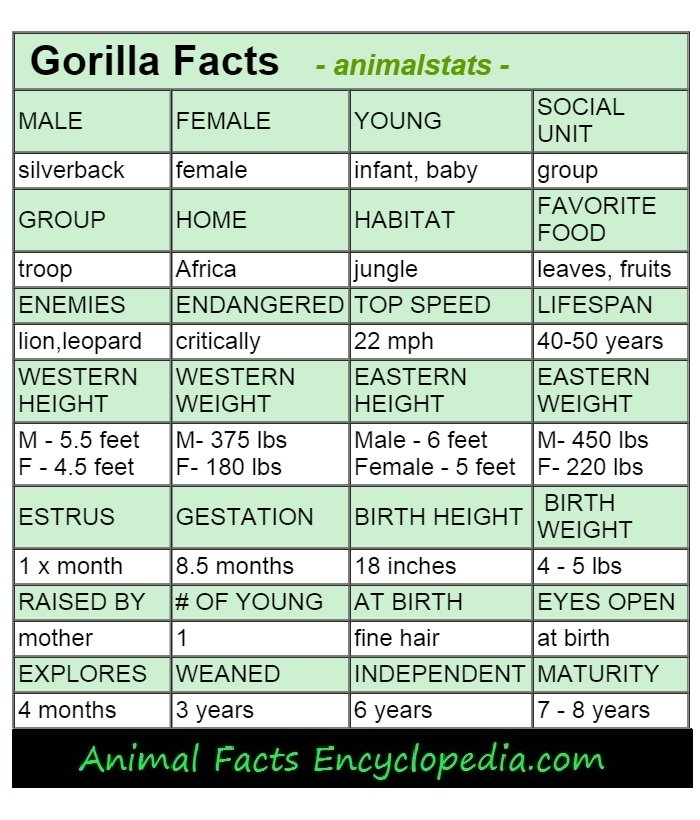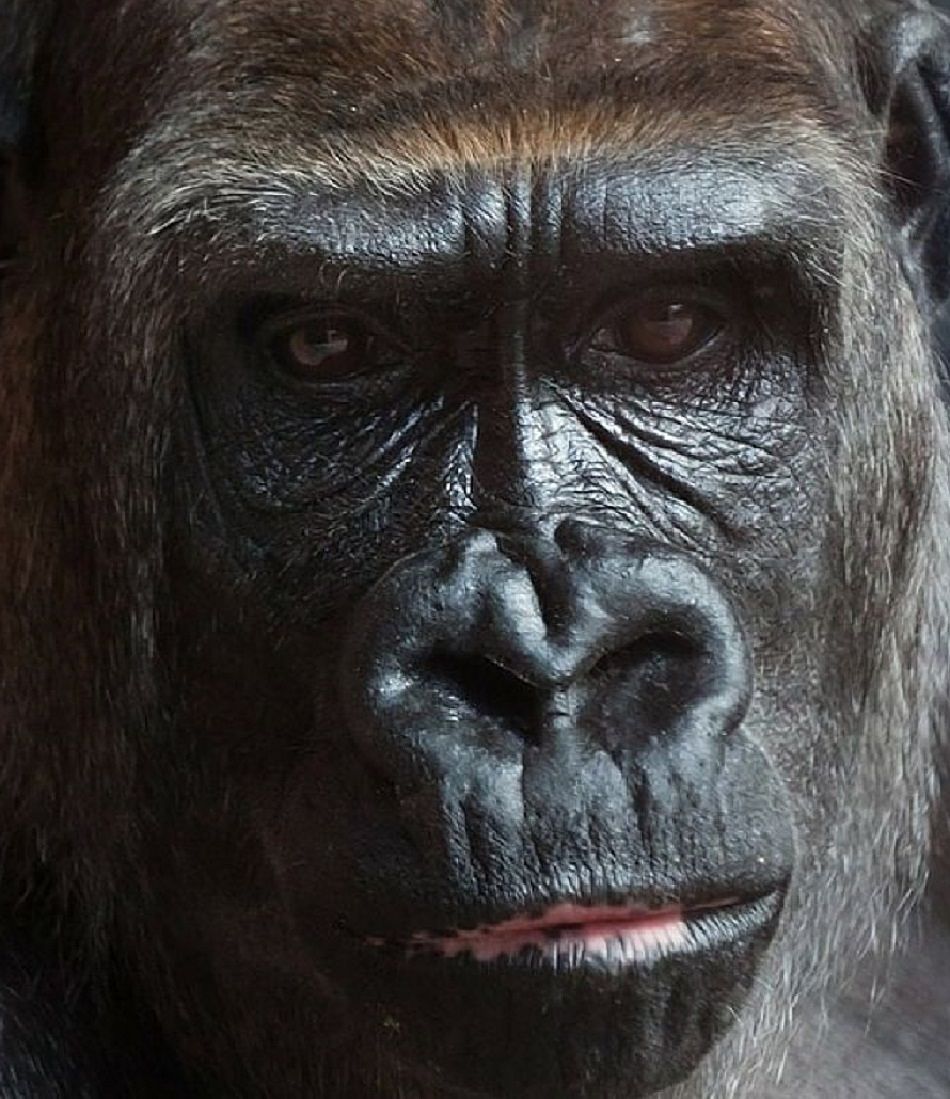gorilla Facts
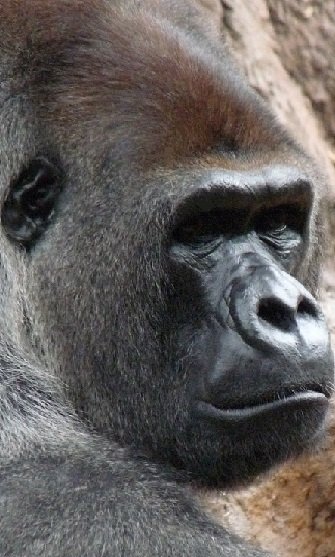 Portrait of a Gorilla
Portrait of a GorillaWith adult males weighing up to 600 pounds and standing six feet tall, the gorilla is the largest of the great apes, and the largest living primate. They live in the jungles and rain forests of Central Africa and the two species and five subspecies of gorilla are all named for the regions and habitats that they call home.
All gorilla subspecies are critically endangered, and even with increasing conservation efforts, the likelihood of maintaining a population in the wild for some of these creatures is very slim.
The gorilla is a terrestrial animal which only spends time in trees during its youth, and while sleeping in a nest at night. Many large males sleep on the ground and never enter the trees after they reach a certain size.
Gorillas are true knuckle-walkers, and spend the most time of all the great apes walking on all fours.
The gorilla is tremendously powerful and uses its strength to rip open tree trunks to retain the softer insides. They are probably exclusively herbivores who eat fruit, leaves, shoots, bulbs, roots and tree bark of nearly 100 different plant species. Only occasionally will gorillas eat insects, like ants and termites.
Gorillas have never been observed hunting, or eating any small game in the wild, but DNA testing of their feces suggests they may eat occasional small creatures - perhaps even monkeys.
With the largest males well over 500 pounds, the gorilla must spend many hours a day foraging and consuming about 50 pounds of vegetation. Their rotund bellies, which expand well out past the girth of the chest, are like large cauldrons that break down starchy foodstuffs like a furnace.
The gorilla has huge, flat molars in the rear of the jaw that grind down difficult foods. They have not only opposable thumbs, but, like all the great apes except for human beings, opposable big toes as well.
They can hold and manipulate things with their feet almost as easily as with their hands.
Gorillas are complex thinkers and tool builders, and most interestingly for their mass, and fierce appearance, are rather gentle and peaceful in their lifestyle, with little violence, free-forming family units, and long, rich childhoods spent learning from their elders.. - Gorilla Facts
western gorilla
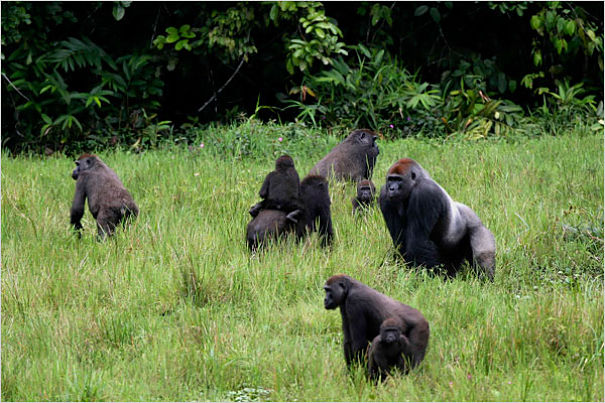
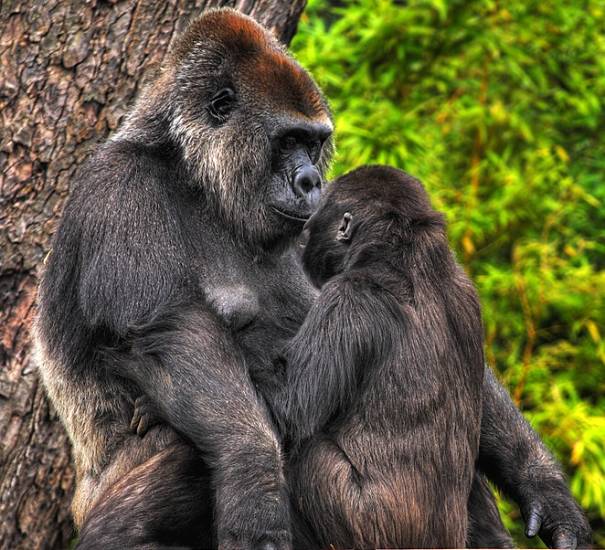
The Western Lowland gorilla is the most populous and most recognizable of the gorillas. Because it lives in lower valleys and ranges closer to populations, it has been studied far more than the other species, and unfortunately, captured more often as well.
Only a handful of Eastern gorillas (about 20) exist in captivity, and there are no known captive mountain gorillas, so the Western is the gorilla you will see in zoos and exhibits.
The Western lowland gorilla is smaller than the Eastern gorilla, but is still gigantic. Adult males are just a few inches shy of six feet tall when standing upright, and can weigh about 475 pounds. Females, as in all the gorilla species, are about half the weight of males, and 60 to 75% the height.
Western gorillas have more of a brownish tone to their fur, especially on the shoulders and head. These gorillas spend the majority of their time on the ground, but build a nest every night, usually in the trees.
The nest building begins about a half hour before sunset, and involves bending branches and weaving them together to form a platform.
This behavior is, in effect, tool making. It involves the careful selection of branches and twigs, using larger diameters for the base, and smaller twigs for the sides.
The gorilla bends, but does not break certain parts of the bed, enabling it to manipulate the branches but still maintain some integrity.
The gorilla will only sleep in the bed for one night, and only mothers with young will share. In the morning the nest is abandoned, and conservationists have become accustomed to counting the number of abandoned gorilla beds they find, to determine the local population. - Gorilla Facts
eastern gorilla
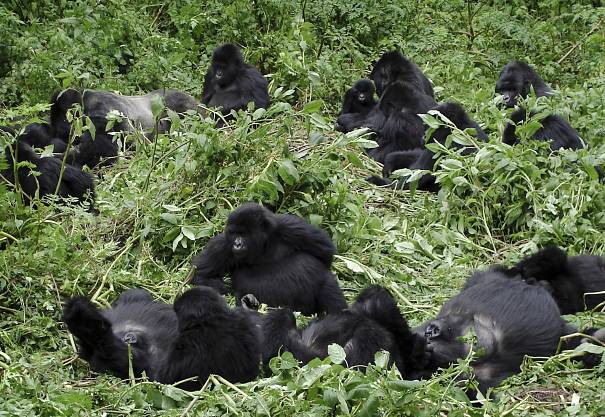 mountain gorillas lounging
mountain gorillas lounging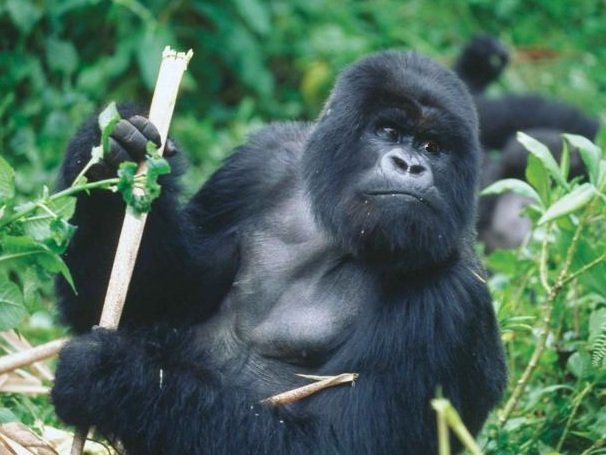 Eastern lowland
Eastern lowlandThe Eastern lowland gorilla is the largest of the gorillas, with the biggest adult males being six feet tall when standing upright.
Some of the largest on record were close to 600 pounds.
Once thought to be just a myth, the more exotic looking Eastern mountain gorilla was only discovered in 1902, They live in high elevations and are covered with very dense, thick, black fur. They also have more rounded heads and very large round bellies.
These gorillas don't have access to as much fruit as the other subspecies and consume massive amounts of leaves in their diet. In general, the amount of silver on the mature male mountain gorillas back is less extensive than that of the lowland gorilla and does not usually extend down into the thighs.
The mountain gorilla, like the other subspecies, moves about in a fairly large territory, browsing only briefly in places and then moving on. They will move and stop about six times a day, from one feeding area to another, and may not revisit that area for weeks after.
Some of this movement has to do with the seasonal availability of food, but some may be just an instinctual drive that prevents them from depleting any one area or food source.
This is not a natural tendency for all animals, and some very intelligent animals like the elephant, often over indulge and destroy their own environment, but the big and ever eating gorilla, is also ever moving, and so protects its own resources in the process.- Gorilla Facts

gorilla reproduction
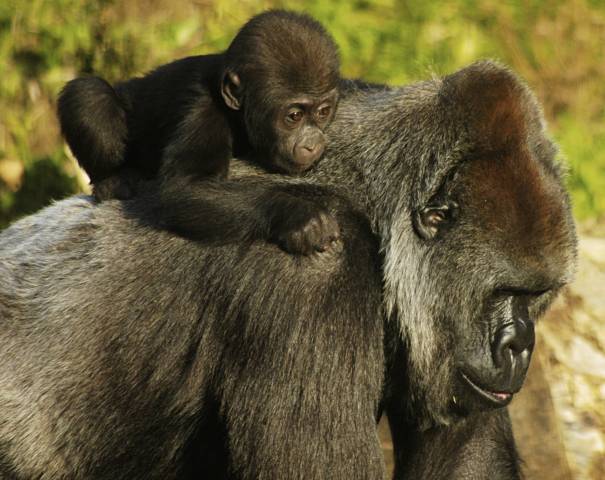 lowland gorilla with baby onboard
lowland gorilla with baby onboard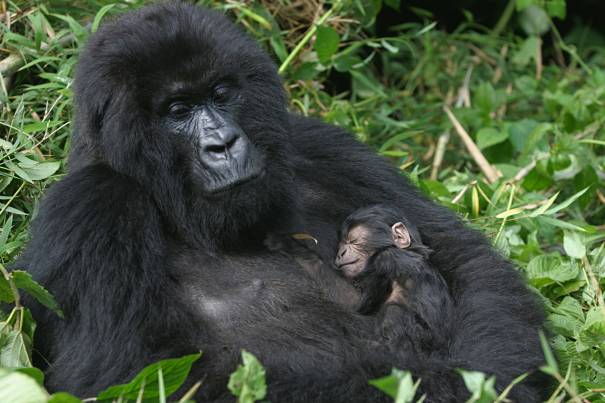 mountain gorilla mother with infant
mountain gorilla mother with infantFemale gorillas are fertile for two to three days per month, but will engage in sexual activity not only out of their estrus cycle, but also while pregnant and lactating.
Like the orangutan, bonobo, and human, gorillas appear to enjoy sexual relations for pleasure, and not just for reproduction.
Gorillas are nowhere near as sexually active as some other great apes, and have not been observed having face-to-face intercourse, but among bachelor males there are rare occasions of mild homosexual activity.
Pregnancy lasts for 8 1/2 months and results in one infant, very rarely two. A newborn gorilla is born eyes open and well-furred. It is quite helpless but for its instinct to grasp with all four feet.
The tiny baby will be held close to its mothers chest for the first few weeks of life and then graduates to riding on her back.
Baby gorillas are basically raised by their mother, but all adults within the troop, including adult males, will interact with youngsters.
Mutual grooming involves all members, and babies may hitch a ride on other adolescents or adults as long as mom is amenable. By four months old the young gorilla can walk and climb on its own, but its range is generally only a few yards from its mothers side.
The gorilla has a very long childhood. nursing until it is three and even four years old, and sleeping in the same nest with its mother until about five. It may build its own nest but still sleep with mom for the first few months of this critical transition, and some youngsters will climb back in bed with their mother if she gives birth to a new infant, in a familiar attempt to cling to childhood.
Both male and female young adults are likely to leave their family troop and form or join a new troop at about eight years old. Groups of young males, called "bachelors", may stay in troops of up to ten individuals.
They wait for an opportunity to pair up with a young female who is ready to leave her mothers troop. Gorilla troops, including groups of bachelor males, have overlapping territories and not only rarely fight, but will occasionally socialize when they come upon each other.
Because troops are made up of many unrelated individuals in order to preserve genetic

diversity, neighboring troops are likely to be made up of relatives, and individuals may visit with their parents or childhood friends.
The long childhood of the gorilla is filled with learning experiences and opportunities for the transmission of culture to the next generation.
Young gorillas are taught by example, and adults other than the mother are often willing to demonstrate different techniques for food gathering, nest building, or any number of other activities.
These skills can be seen being passed along to youngsters within a new troop who may get several different examples of how to do something, from adults who grew up in different troops. - Amazing Gorilla Facts
The incredible silverback
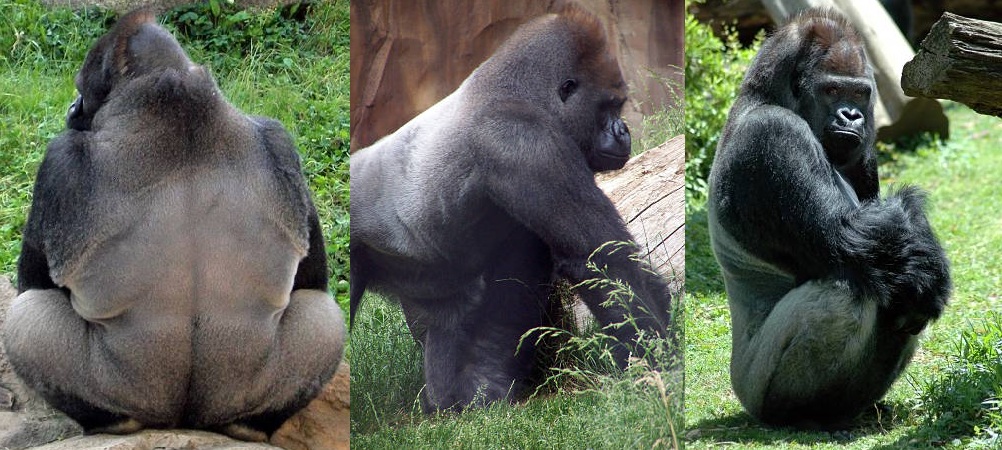
Male and female gorillas are born about the same size, but females reach full growth at about eight years old.
Young males just get bigger and bigger until they fill out completely at about fifteen years old.When he is done growing he will be about twice the weight of an adult female, and about 30 percent taller than her. He also has very large ridges on his skull that form the big conehead look, and serve to anchor his huge jaw muscles.
Females have these ridges as well, but they are much less pronounced
As the young male starts to mature, he will also begin to develop a blanket of silver hair across his shoulders. Before the color develops he is called a blackback. At eight or nine years old he will break out in a bit of salt and pepper between the shoulder blades.

At ten or twelve, when his full mantle is grey, he is known as a silverback.
By the time he is in his twenties, the silver color will reach all the way down the thighs and sometimes across the belly. The male also develops large canine teeth as he matures, which are used more for show than anything else.
It is on a rare occasion however, that two males will have a serious altercation, and death has occurred, usually due to damage inflicted by the impressive fangs. - Gorilla Facts
gorilla intelligence
 the thinker
the thinkerGorillas live in a complex society where young adults leave their family troops to find or create their own social units.
They spread their knowledge and culture this way, and insights into best foods, ripest fruits, smartest techniques for extracting pulp from trees or nuts from their shells, are handed down and demonstrated to one another.
Gorillas in captivity have been taught all manor of tasks and tricks, from ridiculous circus stunts, to experiments as fascinating as using sign language or computer touch screens to communicate.
The most compelling argument for just how profoundly bright the gorilla may be is Koko, a female lowland gorilla who was born in captivity in 1971, and has been the main focus of the Gorilla language project.
Koko has been learning American sign language since she was a year old and knows over 1000 signs. She understands nearly 2000 words of English and has a tested I.Q. on the human I.Q. scale of between 75 and 95!- Gorilla Facts
a few more gorilla facts
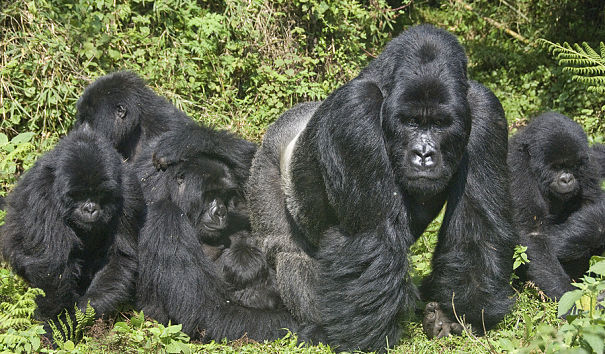

- A group of gorillas is called a "troop"
- The gorilla is the largest of the great apes
- Adult male gorillas are called "silverbacks" for the silver hair that grows on their backs
- Western silverbacks have silver hair down their sides and thighs, Eastern silverbacks have a defined patch of silver between the shoulders.
- Adult male gorillas are usually two times the size of adult females.
- All gorilla species are critically endangered.
- The mountain gorilla was not known to exist until 1902
- Gorillas are almost entirely vegetarian only occasionally eating small insects .- Gorilla Facts!
| Gorilla Facts - animalstats - | |||
|---|---|---|---|
| MALE | FEMALE | YOUNG | SOCIAL UNIT |
| silverback | female | infant, baby | group |
| GROUP | HOME | HABITAT | FAVORITE FOOD |
| troop | Africa | jungle | leaves, fruits |
| ENEMIES | ENDANGERED | TOP SPEED | LIFESPAN |
| lion,leopard | critically | 22 mph | 40-50 years |
| WESTERN HEIGHT |
WESTERN WEIGHT | EASTERN HEIGHT |
EASTERN WEIGHT |
| M -
5.5 feet F - 4.5 feet |
M-
375 lbs F- 180 lbs |
Male -
6 feet Female - 5 feet |
M-
450 lbs F- 220 lbs |
| ESTRUS | GESTATION | BIRTH HEIGHT | BIRTH WEIGHT |
| 1 x month | 8.5 months | 18 inches | 4 - 5 lbs |
| RAISED BY | # OF YOUNG | AT BIRTH | EYES OPEN |
| mother | 1 | fine hair | at birth |
| EXPLORES | WEANED | INDEPENDENT | MATURITY |
| 4 months | 3 years | 6 years | 7 - 8 years |
see more animal extreme closeups
Recent Articles
-
African Animals - Animal Facts Encyclopedia
Oct 11, 16 10:27 PM
African Animals facts photos and videos..Africa is a wonderland for animal lovers, and a schoolroom for anyone who wants to learn about nature, beauty and the rhythm of life -
Baboon Facts - Animal Facts Encyclopedia
Oct 11, 16 10:26 PM
Baboon facts, photos, videos and information - Baboons are very distinctive looking monkeys with long, dog-like snouts and close set eyes. -
Great Apes Facts - Animal Facts Encyclopedia
Oct 11, 16 10:25 PM
Great apes facts, photos and videos..Human beings did not evolve from chimpanzees, modern chimps and gorillas do not appear in the fossil records until much more recently than homo sapiens..
